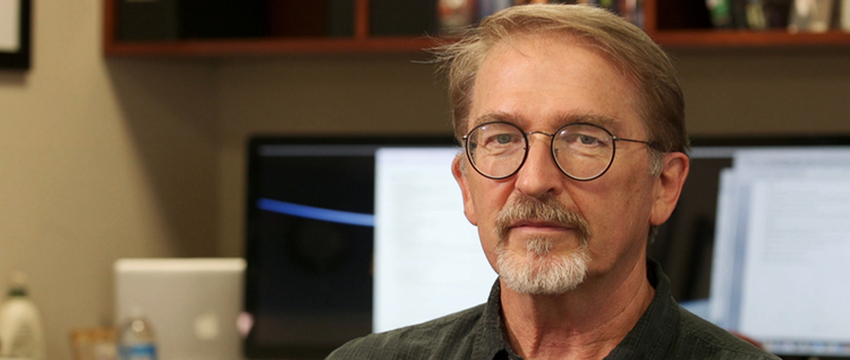
By Doug Carroll, University Relations - Communications, September 12, 2016
Unlike the space mission to which he has given the last 4 1/2 years of his life, Ed Beshore's work is nearly done.
Last Thursday's launch of the OSIRIS-REx spacecraft from Cape Canaveral, Florida, was a "bittersweet moment," says Beshore, who will retire as the mission's deputy principal investigator - and also from the University of Arizona - when he turns 62 on Oct. 4.
"I had a big candle for my retirement cake," Beshore says of the blazing Atlas V rocket that launched the UA-led, seven-year mission to return a sample of surface material from the asteroid Bennu.
"I can't think of a better way to do this. I really wanted to get to launch because I knew it was a natural time for me to retire and a good handoff point to the next deputy principal investigator."
Taking over for Beshore as deputy to principal investigator Dante Lauretta on the mission is Heather Enos, who has been with the UA's Lunar and Planetary Laboratory since 1997 and has served most recently as project planning and control officer for OSIRIS-REx. Under Beshore, the position focused on the development of hardware and on launch planning and preparations. Now it shifts in emphasis to mission operations, for which the nerve center will be the Michael J. Drake Building northwest of campus.
"The two-year timeline (of getting to Bennu) will go very quickly," says Enos, who has been on OSIRIS-REx since 2008.
Beshore says Enos has the requisite operations experience and attention to detail.
"She's going to enjoy the job, and people like working with Heather," he says. "She'll bring the necessary insights into what the mission needs and make sure nothing falls between the cracks."
As for Beshore, he plans to ride off into the sunset - literally. As an undergraduate at the UA in the mid-1970s, he had a BMW motorcycle that he rode all over the West. He plans to resume those travels, this time in a new truck, and to do some backpacking "before my knees give out." He will continue tracking the mission closely, perhaps in a consulting role with NASA.
The cutting-edge work of the UA in space science was a big reason he came back to Tucson after a successful engineering career, joining the Catalina Sky Survey in 2002 and becoming its principal investigator in 2009.
"One of the reasons I wanted to come back is that I wanted to hang out with people who were a lot smarter than me," Beshore says. "You'd have a hard time not finding a whole lot of smart people at LPL. They're all doing fascinating things, and the science that comes out of the place is fantastic. It's a joy to be around."
OSIRIS-REx has been a special project from the start, he says.
"This is not just another mission that has been flown before," he says. "We're doing something the United States has never done before, which is going to an asteroid and bringing back a sample - heck, going to another planetary body and bringing back a sample. That represents a turning of the corner for planetary exploration by the United States.
"I think everybody (on the mission team) knows the world is watching. Everybody thinks it's a cool mission and they want it to succeed, so they put in the extra effort they know is needed to make sure the mission gets done right."
Although the OSIRIS-REx launch was not Beshore's first - he saw Apollo 14 lift off as a teenager, and he later watched the Mars Polar Lander and Phoenix Mars Lander launches - it left an impression all its own.
"It was exciting, beautiful, bright and loud," Beshore says. "It was a spectacle, and it was just great. ... (The launch) was a moment of pride, to be able to say, 'The University of Arizona has been doing this for 50 years, and we're really at the top of our game right now.'"

